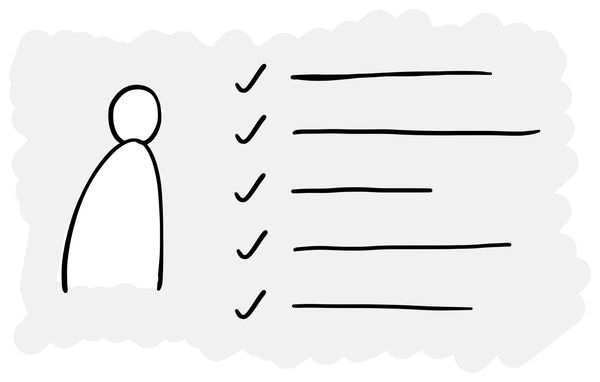Why researchers should think like marketers
Generating insight is only half of the story.

The ultimate goal of any UX researcher isn’t to do research. It’s to generate empathy for customers in the minds of the people making decisions about the experience.
They do this by:
- Gathering evidence about what customers need and how they use the product or service that they’re working on.
- Synthesising all of the evidence they’ve gathered into meaningful insight.
- Sharing what they’ve learned with people who make decisions about the customer experience.
Too many researchers focus on the first two steps and neglect the third one. They collect valuable insights but fail to make an impact because their distribution of what they’ve learned falls short.
This can leave researchers feeling that they’re not listened to, and their stakeholders wondering what their value really is.
You can’t really blame researchers for this, because there’s so much involved in gathering evidence and turning it into insight, especially with the increasing time pressure we all find ourselves under.
Yet if we step back, there are some simple ways that we can increase the impact our research has by looking at how professionals who do this third step for a living work. These people are marketers.
Insight is the product you’re selling
Think about insight as the ‘product’ that researchers ‘make’. How do most researchers ‘sell’ their insight?
When most finish a project, they present some slides to their colleagues and then put the file on SharePoint where it may never be read again. It’s no surprise that some researchers struggle to deliver the impact that they should be, given the power that insight can have.
What would a marketer do differently?
When marketers sell a product, they go through a structured process: understand the audience, craft compelling messages, choose the right channels, run campaigns to drive action and measure the impact.
Step 1: Define your audience
Researchers excel at understanding customers, but often place less emphasis understanding their internal stakeholders.
Think about how to apply the same rigour internally. Map out the different personas in your organisation:
- Who is deeply invested in your work versus who barely knows about it?
- What are their different roles, incentives and interests?
- How do they currently use customer insight in their decision-making?
Different people need different things from your research, just like different customer segments have different needs.
Step 2: Shape your message
Once you understand your audience, frame your insights to align with what they care about.
If you’re speaking to someone focused on commercial outcomes, connect your findings to revenue impact. If you’re talking to an operations manager, highlight how the insight affects processes and efficiency.
You’re not changing the insight – you’re highlighting different aspects of it, just as a marketer emphasises different product features for different audiences.
Step 3: Choose your channels and formats
Think about all of the communication channels available to you:
- Internal wikis
- Slack/Teams channels
- Weekly updates to leadership
- The office walls, desks, etc.
- Monthly all-hands presentations
- One-to-one meetings with key stakeholders
Then think about all of the different formats you could use:
- Video
- Slides
- Custom GPTs
- Memes and humour
- Infographics and posters
You need to match your format to your message and audience. A busy executive might need a two-minute video summary, whilst a product manager might want detailed findings they can reference later.
Think beyond reports and imagine what would go viral in your company (i.e. PPTs don’t go viral, videos do).
Step 4: Run a campaign
Marketers don’t send one email and call it done. They create multiple touchpoints, repeat key messages and build momentum over time.
Researchers often share their findings once – in a report and a debrief meeting – then wonder why nothing changes.
Instead, plan a series of communications across different channels. Share key insights in multiple formats, at different times, through various moments:
- Run a debrief for the core team you’re working with.
- Create a 2 min summary video and share it on Slack.
- Give a 5 min update in a monthly all-hands.
- Etc.
This might feel like overkill, but repetition is how messages stick.
Step 5: Measure and improve
Track how your communications land. You might not have access to marketing analytics through these channels, but you can still gather feedback:
- Monitor reactions on Slack or in meetings
- Check page views on internal documentation
- Ask stakeholders directly what formats work best for them
Use this feedback to iterate your approach, just as you’d iterate research methods based on what works.
But I don’t have time for this!
In an environment that pressures researchers to do things faster, this seems like a lot of extra work on top of an already demanding job. But remember: there’s no point producing an incredibly robust report if no-one acts on it.
It’s also the job of the research team’s leader to make this easier for everyone. Your Head of Research needs to act like the CMO of your insight:
- Setting up templates to make it easier to do.
- Maintaining a list of your top insights that you can market a.k.a. your ‘product portfolio’.
- Overseeing the sharing of the biggest insights you’re generating.
- Making time and space for researchers to do marketing.
- Opening up opportunities to share insights in different channels and with different audiences.
The researchers who have the biggest impact aren’t necessarily those who conduct the most rigorous studies. They’re the ones who excel at getting their insights into their colleagues’ minds and influencing how decisions get made.
Your job isn’t finished when you’ve done the debrief. It’s finished when those insights have generated empathy for customers in the people who matter most: the ones making decisions about the experience.





